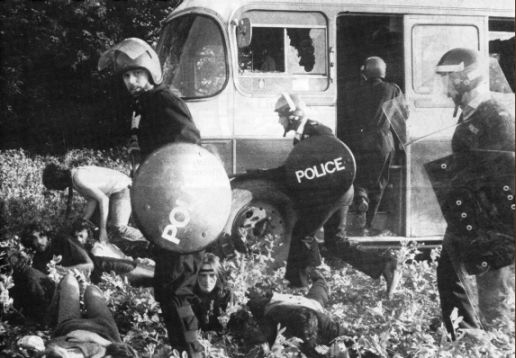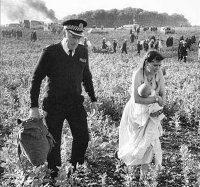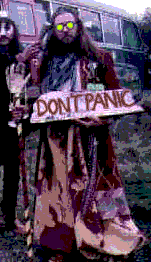25 years ago, in a field beside the A303 in Wiltshire, the might of Margaret Thatcher's militarised police descended on a convoy of new age travellers, green activists, anti-nuclear protestors and free festival-goers, who were en route to Stonehenge in an attempt to establish the 12th annual Stonehenge free festival in fields across the road from Britain's most famous ancient monument. That event has become known as the Battle of the Beanfield.
In many ways the epitome of the free festival movement of the 1970s, the Stonehenge free festival – an annual anarchic jamboree that, in 1984, had attracted tens of thousands of visitors – had been an embarrassment to the authorities for many years, but its violent suppression, when police from six counties and the Ministry of Defence cornered the convoy of vehicles in a field and, after an uneasy stand-off, invaded the field on foot and in vehicles, subjecting men, women and children to a distressing show of physical force, was, like the Miners' strike the year before, and the suppression of the printers at Wapping the year after, a brutal display of state violence that signaled a major curtailment of civil liberties.
In the context of political dissent at the time, the Stonehenge festival was a mere sideshow, but the government knew that its suppression would not cause offence to the general public, especially as most media outlets were prevailed upon to refrain from reporting on it (valiant exceptions were the Observer's Nick Davies and Kim Sabido for ITN). As a result, the government knew that it could disguise its other motives: the curtailment in general of the British public's right to gather freely without prior permission, and the suppression of a grassroots movement opposed to the installation of US cruise missiles on UK soil.
The most celebrated opponents of nuclear weapons in the UK were the women of Greenham Common, but as it would have been a PR disaster to have had police truncheoning a group of women, the new age travellers, who had set up a peace camp at RAF Molesworth in Cambridgeshire (the proposed second base for cruise missiles) were a more obvious target, and the Battle of the Beanfield took place just four months after 1,500 soldiers and police – in the largest peacetime mobilisation of its kind – were used to evict the camp.
Above all, though, the major fallout from the Battle of the Beanfield was the government's manipulation of the manufactured hysteria about the travellers and protestors to introduce the 1986 Public Order Act, which enabled the police to evict two or more people for trespass, providing that "reasonable steps have been taken by or on behalf of the occupier to ask them to leave." The act also stipulated that six days' written notice had to be given to the police before most public processions, and allowed the police to impose unspecified "conditions" if they feared that a procession "may result in serious public disorder, serious damage to property or serious disruption to the life of the community."
The Battle of the Beanfield was not the end of grassroots dissent in the UK – although it gutted the travellers' movement – as a new "threat" emerged just a few years later, when the acid house scene, with its giant warehouse raves and outdoor parties, once more threw the government – and the tabloids – into an authoritarian frenzy. As with Stonehenge, the catalyst for a further assault on civil liberties was another large free festival, at Castlemorton common in Gloucestershire, on the May bank holiday weekend in 1992.
The legislation that followed – the 1994 Criminal Justice Act – not only repealed the 1968 Caravans Sites Act, criminalising the entire way of life of gypsies and travellers by removing the obligation on local authorities to provide sites for gypsies, but also amended the Public Order Act by introducing the concept of "trespassory assembly." This enabled the police to ban groups of 20 or more people meeting in a particular area if they feared "serious disruption to the life of the community," even if the meeting was non-obstructive and non-violent, and the act also introduced "aggravated trespass," which finally transformed trespass from a civil to a criminal concern.
Both had disturbing ramifications for almost all kinds of protests and alternative gatherings, and were clearly ramped up after the government failed to secure convictions after the Battle of the Beanfield using an ancient charge of "unlawful assembly." Moreover, as protestors have been discovering in the years since the passing of the Criminal Justice Act, the groundwork laid by the Public Order Act and the Criminal Justice Act provided the Labour government, which has passed more legislation directed at civil liberties than any previous government, to start from a presumption that there were few, if any instances when a peaceful protest by just two people could not be suppressed.
Back in 1997, some of us had a quaint notion that the government would repeal the excesses of the Criminal Justice Act; instead, we are living with three other changes enacted by the Act that still have resonance today: the police's right to take DNA samples from those arrested, increased "stop and search" powers, and amendments to the right to silence of an accused person, allowing inferences to be drawn from their silence. We have an exclusion zone around parliament, in which a single non-violent protestor can be arrested, anti-terror legislation used to stifle dissent, and, as we saw at the G20 protests in April, policemen once more hiding their identification numbers – as they did at the Battle of the Beanfield – to enable them to assault civilians (or worse) with impunity.










